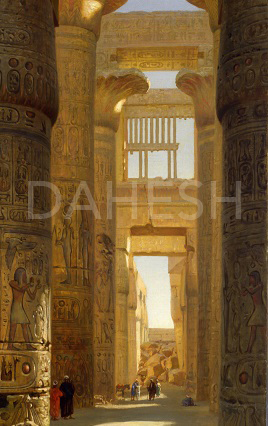Ancient Egypt was a continual source of inspiration for 19th century artists, who documented its ruins, depicted historic events, and reimagined everyday life from the Nile’s distant past. Europe’s fascination with Egypt was ignited by Napoleon Bonaparte’s expedition in 1789, which resulted in the discovery of the Rosetta Stone (196 BC, British Museum) and the publication of the encyclopedic Description de l’Égypte (1809–1828), compiled by Napoleon’s team of scholars. Containing more than 800 engravings, works like Charles-Louis Balzac’s view of the ruins on Philae or André Dutertre’s interior of the tomb of King Ramsses II inspired Europe’s Egyptomania, a taste for ancient Egyptian art and culture.
Travel to Egypt was both costly and time consuming––especially at the beginning of the 19th century––but artists could learn about the Nile’s history from books and new archaeological collections in Europe’s museums. These institutions had been greatly enriched by tomb raiders and excavators like Bernardino Drovetti, Henry Salt, and Giovanni Belzoni, who assembled Egyptian collections for the Louvre, the Turin Museum, and the British Museum. Lawrence Alma-Tadema, a leading painter of antiquity, drew on several pieces from the British Museum in his work Joseph, Overseer of Pharaoh’s Granaries (1874), including a wall painting from the tomb of Nebamun and a cartouche of Tuthmosis II, seen on Joseph’s throne. Artists also found inspiration in illustrated books––Edwin Longsden Long, for instance, included in his painting Love’s Labour Lost (1885) a wall mural, toys, vase stand, and stools, illustrated in Manners and Customs of the Ancient Egyptians (1837), by John Gardner Wilkinson.
As travel to Egypt became more accessible, paintings of ruins and ancient sites became increasingly popular. In The Temple of Karnak. The Great Hypostyle Hall (1890), Ernst Karl Eugen Koerner emphasizes the hall’s enormous scale, while Joseph Farquharson’s The Ruins of the Temple at Luxor (ca. 1890) focuses on the general impression of another famous site, though he includes distinctive details like the papyrus bundle columns to the right of the temple. Hermann Corrodi, who first travelled to Egypt during the winter of 1876–1877, used the Kiosk of Trajan on Philae as a backdrop for his genre scene of native men by a fire.
Egyptomania was equally strong in America, and architects produced Pharaonic buildings such as the Washington Monument (Washington D.C.), while painters like Frederick Arthur Bridgman created dreamy works like Cleopatra on the Terraces of Philae (1896). One of several imaginary scenes that Bridgman set in ancient Egypt, the work was acquired by William Randolph Hearst, who hung it at his California castle, San Simeon. The fascination with ancient Egypt continued in both America and Europe into the Art Deco period, thanks to Howard Carter’s discovery of Tutankhamun’s tomb in 1922.







